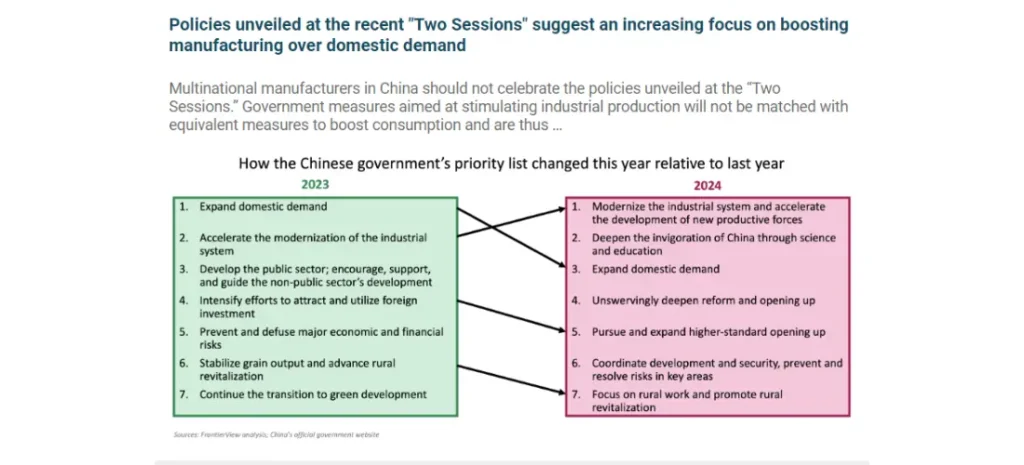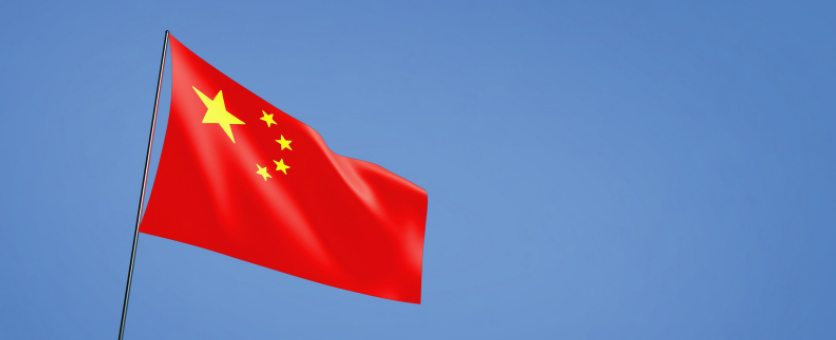
The risk of overcapacity looms large, as China’s demand will likely be too weak to absorb its output
Multinational manufacturers in China should not celebrate the policies unveiled at the “Two Sessions.” Government measures aimed at stimulating industrial production will not be matched with equivalent measures to boost consumption and are thus likely to result in a rising tide of overcapacity. As a result, B2B firms in many industries will face a tough choice this year in terms of pricing and profitability: either cut prices to boost sales and risk eroding their margins, or maintain prices and profitability at the expense of losing market share to competitors, especially local companies that have access to preferential financing, are willing to accept lower margins, and are usually more aggressive in price-cutting. Multinational executives must consider their options carefully and drive internal alignment around a clear goal, while at the same time building flexibility into their volume and revenue forecasts.
Companies focused on exports, specifically to mature markets like Europe and the US, should monitor global pricing trends and stay vigilant to rising protectionist sentiment. Governments in some markets have already begun laying the groundwork for anti-dumping measures that could substantially disrupt export flows. Executives in China should maintain active contact with their counterparts in headquarters and peers in other regions to get ahead of these trends and, as necessary, build plans to mitigate the impact from any imminent protectionist measures that could affect their businesses.
Companies that directly cater to Chinese consumers should brace for a prolonged period of weak consumer confidence. Executives on the ground should clearly communicate to their headquarters that revenues and profits could become more volatile and unpredictable this year, necessitating prudent cost management and flexible forecasting. Businesses that typically rely on young professionals for a substantial part of their revenues should err on the side of caution in their revenue projections, as youth unemployment is unlikely to improve in the near future.
Overview
- China held its most important annual legislative meeting this month, the so-called “Two Sessions.” At the event, leaders released several economic targets for 2024. Among the most important were a GDP growth target of 5%, a fiscal deficit target of 3%, and an inflation target of 3%.
- At the meeting, China’s leaders did not introduce major stimulus measures, unveil a comprehensive plan to address the country’s current debt challenges, or release compelling policies to stabilize the troubled real estate sector.
- Instead, they emphasized their intention to prioritize industrial development and production this year, directing the country’s focus toward sectors involving high-end production and green technologies, such as electric vehicles and batteries.
- After the Two Sessions, China released combined data for the first two months of the year that showed a marked divergence between production and consumption growth trends.
- Industrial production grew 7% YOY in January and February (on an accumulative basis), up from 6.8% YOY in December. Fixed-asset investment in manufacturing jumped 9.4% YOY in the first two months of this year, a massive uptick from the 6.5% YOY in December.
- In contrast, consumption grew just 5.5% YOY in January and February (on an accumulative basis), scaling back from the 7.4% YOY logged in December 2023. Catering revenues, instead of soaring due to Lunar New Year holidays, rose only 12.5% YOY in the first two months of 2024, much less than the 30% YOY recorded in December.
Our View
Chinese leaders will find it challenging to achieve their 5% growth goal this year, particularly because they will no longer be aided by base effects from the previous year’s underperformance. Fiscal stimulus would help them achieve this goal, but the flat deficit target of 3% along with official rhetoric makes clear that Chinese leaders are reluctant to employ this tool. As a result, officials will need to think outside the box to deploy additional resources, possibly leveraging off-balance-sheet funding to spur growth while adhering to official targets. This will likely result in more volatile and less transparent decision-making processes.
The government’s emphasis on industrial production suggests that a significant portion of growth this year will stem from the supply side. There will be heightened investments in the manufacturing sector, particularly in areas aligned with the concept of “new productive forces”—a catchphrase describing high-end, high-tech, and green technologies, where output will almost certainly grow robustly. The much higher growth of manufacturing investment and industrial output in the first two months of 2024 likely signal the start of this trend. Conversely, demand-side factors are likely to remain subdued throughout the year, as attested by the numbers of the first two months. Consumers face massive challenges, including a struggling real estate sector and a grim job market. Overall retail sales are likely to disappoint as long as sentiment on the property market remains subdued.
China’s leaders’ drive to support growth via production instead of consumption is likely to result in a situation where China’s domestic demand is too weak to fully absorb its industrial output. Under these conditions, China will be forced to seek new markets abroad to absorb its surplus capacity. With global demand set to remain soft, exporters will likely have to adopt aggressive price-cutting strategies to offload products, driving down global prices and putting immense pressure on numerous producers worldwide. Trade tensions are almost certain to rise, driving a proliferation of protectionist measures.
At FrontierView, our mission is to help our clients grow and win in their most important markets. We are excited to share that FiscalNote, a leading technology provider of global policy and market intelligence has acquired FrontierView. We will continue to cover issues and topics driving growth in your business, while fully leveraging FiscalNote’s portfolio within the global risk, ESG, and geopolitical advisory product suite.
Subscribe to our weekly newsletter The Lens published by our Global Economics and Scenarios team which highlights high-impact developments and trends for business professionals. For full access to our offerings, start your free trial today and download our complimentary mobile app, available on iOS and Android.

